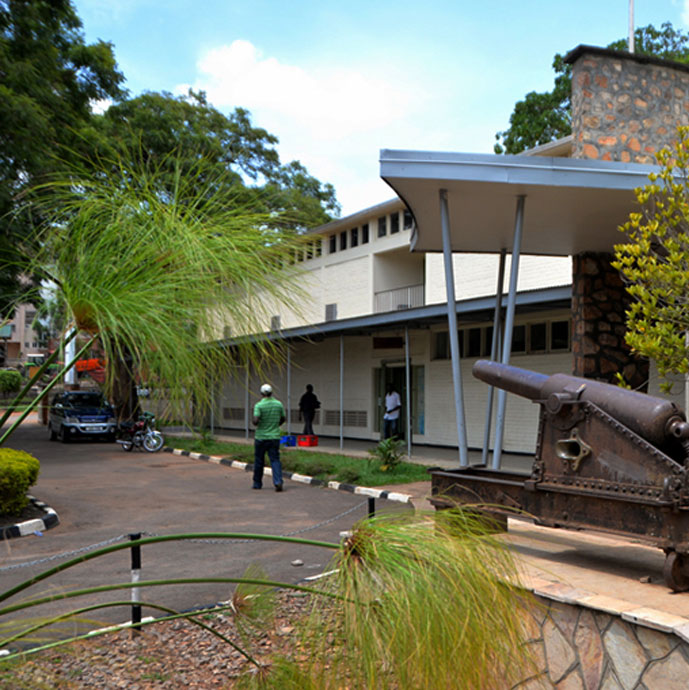The Uganda Museum (A village of culture).
The Uganda Museum is found in Kampala, displaying and exhibiting ethnological, natural-historical and traditional life collections of Uganda’s cultural heritage. It is a home to over 3,000 volumes of historical maps, periodicals and photographs. You will also find various archaeological artifacts, as well as ethnological and historical exhibitions that celebrate Ugandan’s cultural heritage. It is a vivid reminder of the country’s colourful past which makes it a site worth visiting.
If you are in need of a great throw back at Uganda’s cultural background, in addition to the present state of Uganda’s social, cultural, economic and political aspects; the Uganda museum should be on your bucket list during your next safari in Uganda, for there are very few places where one can find traditional African culture tools and equipment used by the ancient Africans used before the colonization era. The Uganda Museum has been in existence for over 100 years, now located at Kitante hill (about 3 kilometers from the city center) in the heart of Kampala. Dating back in 1908, the Uganda museum is the oldest museum in East Africa, which is mandated to Protect, Promote and Present the cultural and natural heritage of Uganda through Collection, Conservation, study and information dissemination for leisure / recreation, research and education.
The museum undertakes research across the country in collaboration with national and international institutions of higher learning like Mbarara University, Makerere University, College de Franca, Natural History Museum in Paris, University of Michigan, etc. Intensive research has been carried out in areas of western rift to Dellu, Karamoja region and Eastern Uganda on the foothills of Mount Elgon (Bukwo). Interesting fossils in relation to human evolution have also been identified by Paleontological research unit.
The Museum building was designed with ample natural lighting and proper ventilation to ensure long term preservation of these historical and cultural objects.
The Uganda museum was designed by a German Architect, Ernst May and the building still stands as a renowned cultural landmark in Uganda and east Africa at large.
Sensitization and preservation of rock art sites in Eastern Uganda has been greatly enhanced and a nomination dossier has been prepared for the nomination of Nyero Rock Art paintings on the UNESCO world heritage list. Other sites on the tentative list awaiting nomination, include the Bigo Bya’Mugyenyi, Kibiro Salt Gardens, Namugongo Martyrs shrine and Ntusi archaeological sites
The Uganda national Museum is divided into various sections;
Music gallery
Comprises of a collection of musical instruments from all parts of Uganda important in communication and entertainment purposes. The instruments are arranged according to the major groups of music instruments for example drums, percussion, wind, string instruments, flutes, xylophones, among others.
Science industry sector
The science section contains stones, mineral samples like limestone, phosphate, tin, iron, wolfram among others, and rocks that are found in Uganda. It also displays transport means especially the Dhow and Canoes that were used by the Arabs into Uganda and the Litter that was used to carry Ugandan kings and queens.
Early history
What makes this sector so interesting is the fact that it displays the evolution of man up to present. It also contains the tools which were used for hunting e.g. spears, horns and arrows. Iron implements that were made from iron ore, they include cloth that was made from the back of the fig tree for clothing especially among the Bantu. Different historical sites on display include The Kasubi tombs, “Bigo bya’mugyenyi”, “Kibuuka Omumbale” and the shrine of the Kabaka of Buganda.
Living museum.
This contains the traditional huts which are built just outside the museum and rewards visitors with insight into the life of an ancient African and their early settlement. On display also are the cars that have been driven by former Ugandan presidents.
The Uganda museum has created space for new exhibits. A particular place is reserved to showcase the modern way of living as compared to the past life.
During the museum tour, Namuwongo- a city suburb in Kampala city was showcased. Total of six families were sampled and interviewed about the kind of living and the pictures were taken and displayed in the museum. Every place is showcased for one month.
Don’t miss out on a visit to this cultural village in Uganda and explore one of Africa’s finest historical past and enhance your cultural tour in Uganda.
